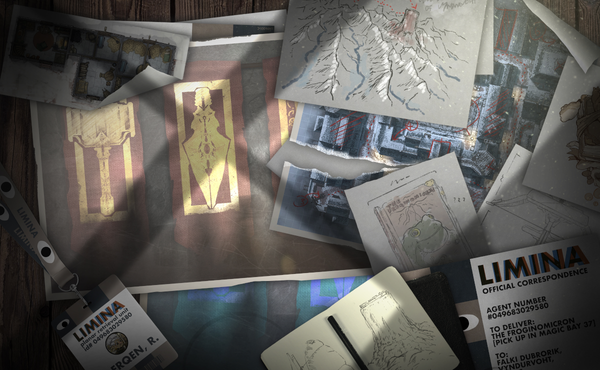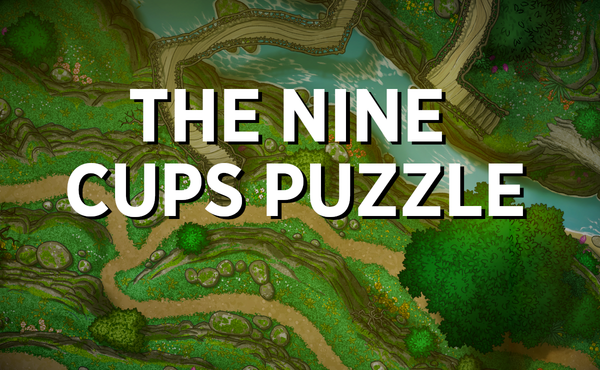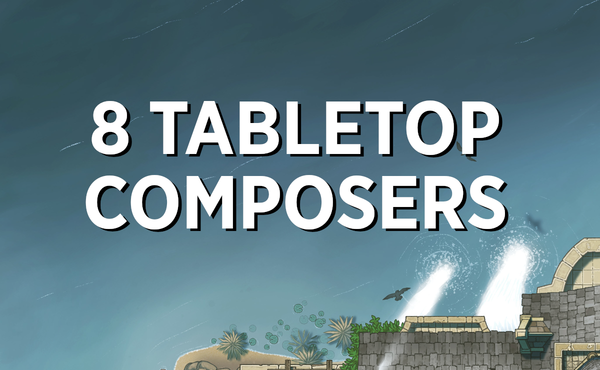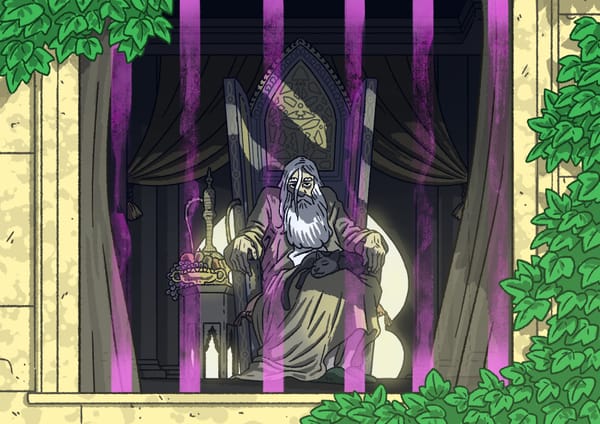The Social Dungeon
Everything you need to run unique quests that prioritize non-combat skills

As a GM, I love collaborative storytelling, complex intrigue plots, and sandboxes. There’s nothing I enjoy more than plopping a party into a new city and seeing how they choose to interact with the NPCs, the environment, and the mechanics of the game. Unfortunately, I find that there are very few guides that demonstrate how to structure those sessions compared to the wealth of tips for running combat or dungeons.
I’m sure you’ve had the experience of presenting a new city for players, and they just say “okay, can I do some shopping? Alright, now where’s the tavern?” Depending on what sort of campaign you’re running, maybe they may make a beeline for some questgiver and then immediately dash off into the wilderness. And that’s fine…
but it’s also the bare minimum.
Utilitarian urban roleplaying leaves very little room for adventuring within the city, unless there’s some local dungeon or something to kill. Again, that’s fine! It’s totally reasonable to send your players off to a catacomb or to slay some rats in a basement. However, that always feels like a missed opportunity. A city—or a village, manor, or other populated space—offers so many different flavors of questing. Condensing a city’s function down to lore dump + shopping mall + quest dispensary serves only a narrow variety of adventures.
I’ve always gravitated toward GMing urban campaign arcs, but I’ve only recently figured out how to formalize the process of designing and running these adventures. I call this format of questing the “social dungeon.” It’s become an exceedingly helpful framework to use when conceptualizing adventures that have less emphasis on violence and an extra layer of interactive complexity beyond the standard tactical battles of D&D and other combat-centric RPGs.
At its best, a social dungeon provides novelty, fleshes out the larger story of a campaign, and gives your players a chance to flex their abilities that don’t often find use in traditional dungeons. A social dungeon can be a murder mystery, an election, a manhunt, an escape, or some multi-layered family drama. This blog post will help explain how I design social dungeons, how I run social dungeons, and some additional considerations. A future blog post will provide a guideline of how you might use these tips in tandem with the content we release on our Borough Bound Patreon.
A note on systems: This framework is completely system-agnostic, and there are no real "mechanics" built in. Yes, this is compatible with D&D 5e. Yes this is compatible with Pathfinder. Yes, this is compatible with the one-page RPG you just picked up on itch.io.
What Is a Social Dungeon?
A social dungeon has four components, each of which I’ll describe in greater detail below.
- A populated location
- A discrete goal
- A non-combat challenge
- A breadth of NPCs and sub-locations
So long as you nail these four elements, you’ve already got the tools you need to start GMing your social dungeon, especially if you’re comfortable with a little bit of improv or random tables. Let’s see what this might look like in practice.
Populated Location
A populated location can be anything, and I worry that even phrasing it as “a populated location” might serve to hamper your own imagination. A city is a populated location, but so is a chalet in a snow storm, a ship on open seas, a war camp, a courtroom, or a divine bacchanal. My instinct is to say that “location” implies a bounded space—that is: “the entire world” does not make for a great location—and it is easier to run a social dungeon if the adventurers can’t or won’t want to immediately leave the location. Nevertheless, I want to reiterate that “location” should be interpreted as broadly as possible.
“Populated” should also be open to interpretation, though it’s crucial that your adventurers are able to communicate with the other NPCs. A city filled with unintelligent crabs or with aliens who speak a language that the adventurers cannot speak is not going to work as intended, because—surprise!—such NPCs eliminate the possibility for social interaction. Without the means to communicate with the NPCs, your players are going to either ignore the NPCs or fight them. As always, that’s fine, but it’s not a social dungeon.
Usually, my social dungeons are also non-threatening unless/until the players do something to make violence unavoidable. That means that the players can freely explore without immediately falling prey to either scripted or random combat encounters. Now, that doesn’t mean that their actions shouldn’t have consequences. If they try to break into a barracks, or if they wantonly flout the law in public view, there can always be the threat of violence, but if random guards or zombies are hampering them at every turn, roleplaying is likely to take a back seat.

Discrete Goal
This one seems obvious, but it’s the one I myself get wrong the most often. It’s easy to say “ehh, the players will get to location x and then they’ll figure out what they want to do.” Sometimes that’s true, but just as often, they’ll just say “uhhhh okay, where are we supposed to go?” Players need direction. Sometimes that direction will be built in because of the greater quest (“we need to find MacGuffin item x to defeat enemy y, so we’ll need an audience with monarch z first”), but you might also consider including a social dungeon as a means of introducing more plot threads, meaning the next steps are not nearly so obvious.
A social dungeon only works if the players know what they’re doing and why.
The questions, then, are 1) what makes for a good goal? and 2) how do you present that goal?
The best goal is one that can only be achieved by engaging with the NPCs. If the party just needs an object and they know where that object is, then they can always bypass most of the “social” aspects of the dungeon by simply going where the object is and either sneaking in or killing anyone who tries to stop them. A more compelling goal would be something like “figure out where the object is.” In order to do that, the party may need to gain the trust of a faction, conduct some proper sleuthing, or lure out the object’s owner. This goal can still be a binary; that is, the “win-state” is determining the location—and then, presumably, acquiring the object. That need not limit the complexity of the adventure, because achieving this singular win-state will require the party to get creative and engage with many facets of the dungeon (e.g. sleuthing, exploring, chatting, puzzle-solving).
Presenting the goal is trickier. The easiest way is to thrust the party into a situation they’d rather not be in: implicate the adventurers in a murder, trap them in a prison, or threaten them if they fail to achieve some specific outcome. While the party may feel railroaded, they will hopefully change their tune once they realize that their next steps are extremely open-ended. These goals often work well as self-contained adventures: the party arrives at a soirée, and then a murder happens. Boom, you’ve got a one-to-three session murder mystery to GM. Once they solve the murder, they can go back to whatever the hell they were doing in the first place. If the party is hyper-focused on the primary plot thread of the adventure, you can always weave that into the murder mystery, but many parties will be happy to engage with a detached one-off quest as well.
Still, a better option is usually to coax the players into deciding the goal for themselves, even if the goal they seek is one that you have already planned for them. Typically, this means that the reason for the social dungeon is tied to the bigger theme of the campaign. For example, the party needs to fight back against an encroaching army. They arrive at a university town. The university has a bunch of mages. The mages could theoretically fight the encroaching army. There ya go. That’s your goal. Maybe the party decides “hey, we should get some mages on our team,” or maybe the allied army’s general says “hey, get me those mages.” Maybe the mages need to be coaxed out of hiding, maybe they need to be impressed, or maybe they’ll only join the cause if the party can do x, where x is some subgoal.
There is a certain risk involved when concocting a goal for your players to follow, because, of course, players have agency. Your players can always reject the objective that you present. This happens. It’s unavoidable when designing a social dungeon. You present a web of intrigue with an alluring prize if the adventurers can unravel the nuances of the scenario, but the players just don’t take the bait. Ideally, you’ll be prepared with a backup scenario, or you can dangle an alternative incentive to coax the players back to the quest social dungeon you’ve designed.
I have occasionally been overconfident when designing plot hooks to motivate a social dungeon. I put the cards on the table, show the players a new environment, introduce a couple of expository NPCs, and the players say “ehh, we don’t want to do that; let’s instead go straight to location x.” That can derail a session. Remember that you can always just say “okay, I need a couple minutes to prepare.” Take a break, brainstorm some new content for your players to engage with, and pray they take the bait this time. It’s extremely helpful to have some crutch encounter tables at the ready. If the party feels like making their way elsewhere, have them roll for random encounters while they make their way toward scripted content you can write before the next session.
Non-Combat Challenge
A goal that can be trivially achieved does not make for a proper quest. If your goal is “meet with the king,” and all the players have to do is say “we go to the castle and request an audience,” you haven’t designed a dungeon. In a standard dungeon, the “challenge” is combat, traps, and occasionally navigation. Maybe there will be some additional pitfalls such as survival elements, puzzles, or timed threats, but the primary obstacles that the party has to overcome in 90% of RPG dungeons are either “identify and safely get past trap x” and “defeat or sneak past enemy y.”
In a social dungeon, the trick is to provide challenges that are outside the realm of imminent bodily threats. Physical danger absolutely can be present within your social dungeon, but if you want to design a quest that feels notably different from the rest of your campaign, non-combat challenges should take precedence.
The easiest obstacles to implement are obfuscation and incomplete information. Let’s go back to “where is object x.” Not knowing where to find the object is a challenge in and of itself, but what will the players do if they don’t even know how they are supposed to find it? Maybe they’ll go to a library, maybe they’ll ask an NPC, or maybe they’ll put out a bounty for the item. But what if the item is not what they think it is? What if the item is secretly owned by a powerful villain? What if the item was recently used as a murder weapon and the players have accidentally just implicated themselves? The challenge here is one of careful and deliberate information acquisition, and that’s not something you can ever solve by just killing a goblin. [Note: if your PCs know some version of a locate object spell, you better add an additional layer of complexity to the quest.]
Another common challenge is one of timing. A serial killer is murdering one person each night. The players need to suss out either the killer’s location or the next target’s identity as quickly as possible. In my experience, the best challenges in a social dungeon are those that allow for a range of possible “successes.” Maybe the party finds the killer, but not before allowing two more townsfolk to die.
In almost all social dungeons I design, one challenge is simply wooing one or more tough-to-please NPCs. To obtain crucial information, access to a location, or the aid of a faction, the party will have to first befriend someone. This is probably the most “social” element of a social dungeon. The challenge for the party is to figure out what that NPC wants and how to get them on the party’s side. Often, there will be a fact-finding process first during which the party has to determine who the NPC really is, what they want, and how they fit into the larger social dungeon.
While this can be resolved through an ability check, allowing the players to just say “I roll to persuade the NPC” feels a bit cheap to me. Unless the party can actually offer the NPC something they want or logically demonstrate that the NPC ought to be on their side, a persuasion roll should not be an automatic-win button. It is still important to reward players who have put points into relevant skills, but the key is to never make these outcomes binary. A good persuasion roll after some legitimate roleplaying should yield a better result than a bad roll, but this has to be in tandem with some actual socializing.
Consider listening to our Intrigue playlist when social dungeons with plenty of sleuthing!
Breadth of NPCs and Sub-Location
This is where most of your actual prep time will go. For the social dungeon to function, you’ll need a number of people for your players to engage with and a number of places for your players to go. Crucially, these don’t have to be super fleshed out! When I’m designing an NPC, I'll usually just list a name, a race, a few personality quirks, and any faction allegiances, secrets, or desires they might have. You’ll want to have just enough information so that they can have a purpose in the social dungeon. Maybe they have something the adventurers want, or maybe they want something from the adventurers. I know some folks design NPCs with painstaking detail, but a normal NPC in my campaign has a write-up that looks something like this:
Qarta Reebo
- Gnomish woman, heading to Storth eventually. Wealthy. Fancies herself a biologist.
- Southern accent.
- Current going to Midvale to check on her investments
- If murderer strikes again, Qarta gets killed first
- Commoner stat block
For more incidental NPCs (shopkeepers, generic guards, irrelevant townsfolk), I typically go full improv or pull from a random table. If these characters become more important through improvisation, go with it! Write down any important details you improvise in the moment, and tweak the quest as necessary if you inadvertently add wrinkles or contradict yourself. If you unexpectedly imply that a shopkeeper knows more about the thieves guild than he’s letting on… great! You just made your plot more interesting. Unless you’ve crafted a totally airtight murder mystery with a single “correct” solution, making up new plot wrinkles won’t undermine your social dungeon but instead enhance it.
Sub-location are a surprisingly important element of a social dungeon because they help your players to segment the adventure. I say “sub-location” instead of “room” or “building” because I don’t want you to limit how you conceive of these locations. Instead, think of them more like scenes. If your party is at a bar and trying to determine who is lying about their identity, they may decide to go talk to the bartender, then go check out some folks playing cards, and then talk to the doorman. Each of these “scenes” are sub-location that you can use to help you pace your sessions, limit the numbers of NPCs in play at any given time, and slowly dole out relevant information about the location.
Each NPC and each sub-location can be both a tool and a challenge. An NPC can become an ally or a threat. Likewise, certain sub-locations (a jail cell, a treasure vault, a pub, a rampart) might provide clues and resources, or they might serve as puzzle boxes to hamper the adventurers. You don’t need to predetermine whether these people and places are likely to help the party or harm them. A goblin in a dungeon typically only serves to damage the players, but a sentry on a castle wall can either provide useful information or spot the adventurers snooping. Whether each is an asset or a liability depends on how the players choose to interact with your sandbox.
It’s particularly helpful if you pre-determine where NPCs are at the start of the adventure. You can also determine this randomly or fish out NPCs from a list to populate a location as necessary, but having a bit of an idea about where folks might be when you start means you can easily set the scene whenever your players enter a new sub-location.
Note: I will often track down as many stat blocks as possible for my NPCs. These are almost never relevant; if your players decide to pickpocket someone, you can always just make up a perception skill on the fly. However, there is always the possibility that your players will request the aid of someone who has unique skills and an even greater chance that the adventurers will try to fight somebody. Having stat blocks at the ready is useful, even if 90% of your NPCs are just commoners. For D&D 5e, I strongly recommend OUTCLASSED: The NPC Statblock Compendium to help round out the scant few official WotC NPC stat blocks.
Running a Social Dungeon
Running a social dungeon can be a challenge because it requires your players to take a lot of agency. In a standard dungeon, it’s trivial enough for them to say “I go into the next room. What do I see? A goblin? Okay, I attack the goblin.” A social dungeon requires the party to get their bearings and decide for themselves where to go and how to achieve their goal.
If you’ve got the four elements listed above, you should be mostly fine. So long as the players have enough information about what they need to do, all but the most indecisive players will feel comfortable playing with the sand in your sandbox. Still, it can be exceedingly useful to list out some of the options for the players. One of the easiest ways to do that is to give the players either a list of locations they might explore or—even better—a map. The crudest map can do wonders for a struggling party, because all they need to do is select a point of interest and go explore. This is one of the most useful benefits of pre-planning some sub-locations. Of course, if you’re in need of city maps, Borough Bound has a huge range of giant maps encompassing a wide-range of populated locations.
My first instinct when I began running social dungeons was to withhold too much information. There is a type of player that revels in the mystery of an incomplete picture of the plot, but most players will resent being left in the dark about what the hell is actually going on. Let your NPCs give out some exposition. Pepper some useful documents around an environment. Give your players in-game nudges to advance the quest. You can always complicate the plot further, but it’s difficult to regain your momentum if you players get bored or frustrated from a lack of a direction.
By design, a social dungeon is more reactive than a typical dungeon. The ways in which the various NPCs will respond to the players depends almost entirely on the party’s actions. If the adventurers prove to be chaotic jerks, most NPCs will keep them at arm’s length. You don’t need to carefully track “sentiment scores” or anything equally abstract, but having some sense of the party’s reputation is helpful. No NPC should have unlimited patience, and their understanding of who the party is should evolve as the NPCs themselves gain information.
Additional Considerations
- Sub-Dungeons. For longer social dungeon questlines, it can help the pacing if you include a standard dungeon within the social dungeon. One of my favorite quest arcs that I’ve run was a complicated intrigue plot that had a mid-arc quest during which the players infiltrated a foe’s trapped and guarded mansion. The mansion was about as standard a dungeon as you could imagine: there were enemy encounters, traps, a few secrets, a bit of loot, and a final boss. This added a nice change of pace in the middle of a few sessions of sleuthing, conniving, and fraternizing that came before and after.
- Fail-States. In a regular dungeon, death is always the potential fail-state. In a social dungeon, there probably won’t be an omnipresent threat of death. As such, you need to introduce new fail-states; without the potential of failure, a social dungeon becomes an exercise in delaying the inevitable. In a murder mystery, accusing the wrong NPC would be a fail-state. In a “legal defense” quest, a fail-state would be failing to convince the judge or jury of the party’s innocence. The great thing about social dungeon fail-states is that they can be granular (gradations of failure!), and that they almost always segue perfectly into a new quest.
- Going into initiative. Do this often. Especially if the party is split up. It doesn't matter if the turns take more than 6 seconds or whatever. Just do it to help you dictate the action. Initiative does not need to just be for combat. It is a tool for determining what happens whenever players and NPCs are acting simultaneously.
- High-Level Play. The same way you need to introduce stronger monsters to challenge parties in combat as they level up, you will need to introduce greater challenges for high-level social dungeons. The more advanced a party becomes, the more tools they gain that can trivialize many of the challenges in a social dungeon. Especially in D&D, there's a huge amount of powers available to any party, so the NPCs need to be appropriately well decked out. Add weird magic, add more antagonism, add more technology, add more bizarre roadblocks.




